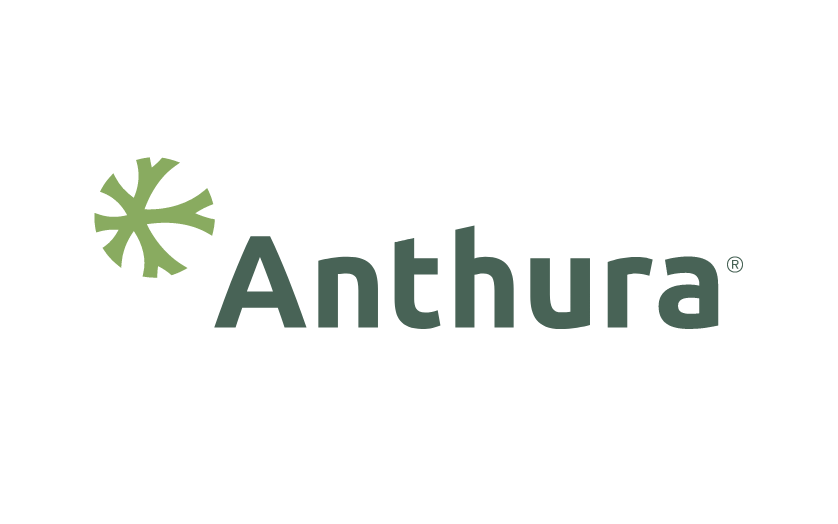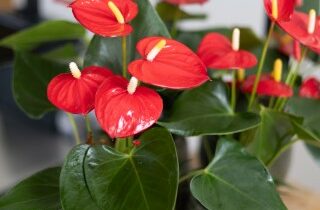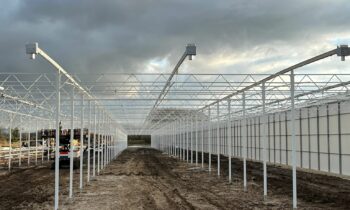The optimum amount (and therefore the proportions between the elements) of nutrients in a solution differs according to each crop and often also its cultivation phase. Over the years, the ideal composition of elements in nutrient solutions changes due to new insights, practical experiences and the results of different studies. This article discusses new insights and experiences for each crop.
Potanthurium
Over the past 10-15 years, there has been a general increase in nutrition. The average EC increased from 1.6 to 1.9 mS/cm (+20%). In the last five years, more and more growers have been giving an EC of 2.0-2.2 mS/cm. This EC increase is necessary to provide the plants with enough nutrients for faster growth and thus guarantee plant quality (leaves and roots).
EC (Electrical Conductivity)
Increasing EC is not always necessary. In the event of poorer growth (both underground and above-ground), it would be better to reduce the EC of the irrigation session. Giving a higher EC can also lead to salinization of the substrate. It is important to adjust the EC in relation to the amount of irrigation water and irrigation frequency. If a grower only irrigates when the substrate is really dry, the chance of salinization is greater than if the substrate is kept moist.

Rustica®
Nitrogen (N)
With the EC increase, more nitrogen is given. The average amount of nitrogen has increased from 8 mmol/l (112 mg/l) to 11 mmol/l (155 mg/l). Some growers provide even more nitrogen, up to a maximum of 14 mmol/l (195 mg/l). The question is whether this increase in nitrogen has any added value. Too much nitrogen can lead to:
– A weaker crop and a higher risk of glassiness in leaves and roots;
– Increased risk of fungus and fungal growth;
– A bigger attraction (nutrition) for insects such as lice and thrips.
It is best to consider the 11 mmol/l as the maximum amount of nitrogen and preferably to give a slightly lower amount of nitrogen of 9 to 10 mmol/l.
Phosphate (P) and Potassium (K)
The amounts of phosphate and potassium have remained fairly stable over the years. Since other elements (in particular calcium and magnesium) have increased, we can say that relatively less phosphate and potassium is now given. On average, 1.3 mmol/l (40 mg/l) of phosphate and 4.5 mmol/l (175 mg/l) of potassium are given. More phosphate can lead to a lower uptake of potassium, calcium, iron and copper by the plant. In spring it is good to increase the amount of potassium by about 0.5 mmol/l (20 mg/l) in order to guarantee the firmness of the leaves and stems in particular.
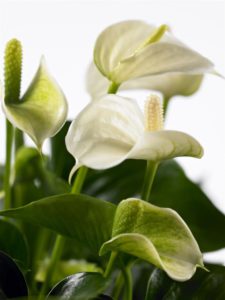
White Champion®
Calcium (Ca), Magnesium (Mg) and Sulphur (S)
In recent years, more attention has been paid to the elements calcium and magnesium. In general, less potassium and more calcium and magnesium are given. The average amount of calcium increased from 2.8 mmol/l (112 mg/l) to 3.3 mmol/l (132 mg/l) and the average amount of magnesium increased (+50%) from 0.9 mmol/l (22 mg/l) to 1.4 mmol/l (34 mg/l). More calcium and magnesium leads to firmer cells, less glassiness, less root rot and a greener crop, and it also reduces susceptibility to diseases. Sulphur (S) (together with nitrogen) is needed for the production of proteins in a plant. These proteins are necessary for the production of chlorophyll, which in turn is important for photosynthesis. On average, 1.7 mmol/l (55 mg/l) of sulphur is given.
Micro elements
Nowadays, more attention is being given to micro elements, mainly because of the functions these elements perform in the plant. In particular, manganese and molybdenum have been increased in the schedules. Boron has also been increased rather than decreased. Manganese has increased to 4.0-5.0 µmol/l (0.22 – 0.25 mg/l). In the past, the amount of manganese was kept low because of concerns about the strong uptake of manganese by the plant at a low root pH. This is rare, but the pH remains an important point of attention. If the pH is above 4.5, no problems with manganese can be expected. At a pH above 6.5, however, there is a high risk of a lack of manganese. An average of 2.0 µmol/l molybdenum and 20 µmol/l of boron are given. Iron and copper have remained fairly constant in irrigation sessions over the years (Iron: 25-35 µmol/l, copper 2.0-3.0 µmol/l). Zinc is given at around 5.0 µmol/l.
| Previous dosages | Current advice | |
| EC | 1.6 mS/cm | 1.9 mS/cm |
| N | 8.0 mmol/l (112 mg/l) | 8.0 mmol/l (112 mg/l) |
| P | 1.3 mmol/l (40 mg/l) | 1.3 mmol/l (40 mg/l) |
| K | 4.5 mmol/l (175 mg/l) | 4.5 mmol/l (175 mg/l) |
| Ca | 2.8 mmol/l (112 mg/l) | 3.3 mmol/l (132 mg/l) |
| Mg | 0.9 mmol/l (22 mg/l) | 1.4 mmol/l (34 mg/l) |
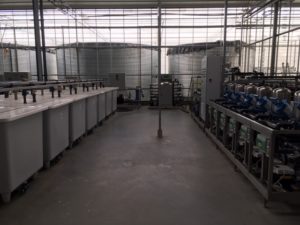
Water room equipped with storage silos,
A and B tanks and irrigation pumps.
Cut Anthurium
In the case of cut Anthurium, there have been many changes in the potassium-calcium ratio and the restriction of leaf yellowing in the last few years with regard to nutrition. Cautious steps are now also being taken with regard to nitrate reduction in favour of quality. In light of this, the amount of EC also varies. The pH deserves extra attention, especially to avoid root problems.
Potassium-calcium ratio
The potassium-calcium ratio has shifted considerably in the direction of calcium. This means that more calcium (Ca++) is now given than before. We have established that an excessive amount of potassium makes the absorption of calcium very difficult in cut Anthurium. Watering also plays an important role in determining the amount of potassium. In the case of more frequent irrigation sessions, the amount of potassium can be lowered as this element is very easily absorbed by the plant. Potassium for plants is like candy for humans. In the event of an imbalance, less Ca++ can be absorbed and embedded. Weak cells are the result and problems with blue and glazing can occur, especially under low light and humid conditions. The advice is:
| Time of year | ||
| Spring/Summer | Autumn/Winter | |
| Ratio of potassium: Calcium | 2:1 | 1:1 |
| In mmol/l at EC 1.3 mS/cm | 4 mmol/l K and 2 mmol/l Ca | |
| In mmol/l at EC 1.8 mS/cm | 4 mmol/l K and 4 mmol/l Ca | |
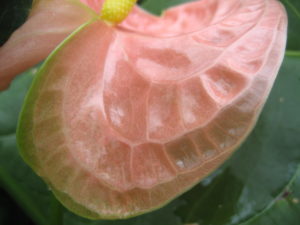
Flower glaze
Spring chlorosis
In spring, when the plant grows rapidly, chlorosis can easily be seen in the young leaves. In addition, the old leaves may yellow due to nitrogen abstraction in favour of the young parts. To reduce this, urea or ammonium nitrate is included in the schedule at this time of year. Ammonium nitrate (max. 1.0 mmol/l) is used for alkaline substrates (generally with a higher pH) or starting water with bicarbonate (HCO3–) because this fertilizer has an acidifying effect. In other cases, urea (max. 3 kg on 100 m³ of feed water) is included in the schedule.

Nitrate abduction from older leaves.
NO3– -reduction
As in the case of pot Anthurium, we are seeing careful steps towards a more balanced amount of nitrate because of a stronger plant. In the feeding schedule, this can be achieved by partially replacing calcium nitrate with calcium chloride, so that this is not at the expense of the amount of Ca++. There is also a tendency to increase sulphate slightly at the expense of NO3.
EC adjustment over the year
A higher EC in the autumn and winter significantly improves quality, provided that this is done with an adjusted feeding schedule. Usually an EC of around 1.8 is maintained. In spring and summer, it is desirable to go to an EC of around 1.3.
Extremely low pH
An extremely low pH in the root environment can cause considerable damage to the root. A low pH is quite common and not a problem and pH levels of up to 3.0 in the drain water are not uncommon. However, if the pH appears to be structurally below 2.6 – 2.8, serious root problems can occur. A lime fertilizer may then be necessary. It is also important to send the correct pH to the greenhouse with sufficiently-buffered water. Buffering should preferably be done with potassium bicarbonate.
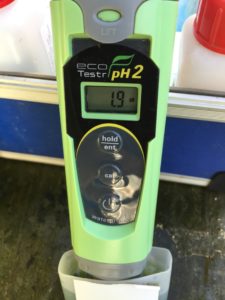
Manual pH measurement that shows an extremely low pH.
Phalaenopsis
EC
Control with EC in the cultivation of Phalaenopsis has always been important. It partly reflects the nutritional status of the substrate, the drain water and the feed water. In the past, there has been a lot of experimentation with the EC control system, and the way up has been well explored. However, it has been shown that this epiphyte cannot withstand a high EC in combination with a lot of urea (±50% of the total amount of nitrogen). The spongy structure of the roots (called velamen) salts quickly, which means that the plant is less able to absorb water and nutrients at a higher EC. Phalaenopsis plants grow and develop best with a nutritional EC between 0.8 and 1.2 mS/cm. In the summer months the plant grows faster and gets more water. The amount of EC may be higher in this period compared to the winter. It is therefore advisable to feed the plant with an EC of 1.0-1.2 mS/cm in the summer months and with 0.8-1.0 mS/cm in the winter months.
Adjusting an irrigation session without EC
If the EC of the drain water and thus the substrate has increased slightly, corrections must be made in order to get the EC back to the desired level. As a rule, when the EC of the drain water deviates more than 0.2 mS/cm from the EC of the irrigation water, this kind of correction is advisable. Usually a complete irrigation session without nutrients (‘clean water’) is carried out. Another strategy is to divide the irrigation sessions into smaller turns that differ in terms of nutrition. For example, the EC of the last two litres can be set lower (e.g. 0.2 mS/cm) or you could supply no nutrients at all in the last two litres. Such a strategy also offers the possibility of applying a biological control or a pH buffer with potassium carbonate, for example.
Urea
In the cultivation of Phalaenopsis it is customary to give a relatively high amount of urea, up to 50% of the total supply of nitrogen. A major advantage is that the EC of an irrigation session remains relatively low with a larger supply of nutrients. Urea is partly absorbed by the leaf under certain circumstances, although there are considerable differences of opinion about this. The disadvantage of administering urea, however, is that the EC will increase again if urea decomposes into ammonium (NH44+) and then into nitrate (NO3–). The new strategy is to reduce the urea-nitrogen content to approximately 25% and increase the EC. The amount of nutrients given in such a schedule is exactly the same, but the EC increases much less quickly. The total amount of nitrogen is normally 12-14 mmol/l (168-196 mg/l). The EC in such a schedule is between 1.3 and 1.5 mS/cm.
Relationships between elements
Through progressive insight, the relationships between the elements have changed slightly. This is partly due to modified substrates. Coconut substrate has a negatively-charged complex that binds potassium. Because this complex attracts more divalent elements than the univalent potassium, these elements are exchanged with each other. A potassium surplus and a calcium deficiency could then occur. This is therefore taken into account in the feeding schedule in order to avoid such a deficit or surplus.
Nutritional advice for an EC of 1.0 mS/cm
| N | P | K | Ca | Mg | S | |
| Substrate with coconut | 12-14 mmol/l
168-196 mg/l |
1.2 mmol/l
38.4 mg/l |
2.5 mmol/l
97.8 mg/l |
2.0 mmol/l
80.2 mg/l |
1.0 mmol/l
24.3 mg/l |
0.5 mmol/l
16.1 mg/l |
| Substrate without coconut | 12-14 mmol/l
168-196 mg/l |
1.5 mmol/l
48.0 mg/l |
3.5 mmol/l
136 mg/l |
1.2 mmol/l
48.1 mg/l |
0.6 mmol/l
14.6 mg/l |
0.6 mmol/l
19.3 mg/l |
